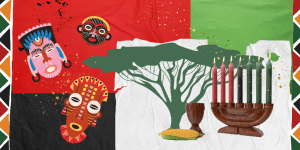
Kwanzaa is a pan-African holiday that celebrates culture, community and family by joining communitarian values and practices of Africans and African Americans. The holiday is celebrated for seven days, beginning on December 26 and ending on January 1. It was created by Dr. Maulana Karenga, a professor of Africana Studies in 1966. The word Kwanzaa means in Swahili: “First Fruits,” with Dr. Karenga taking inspiration from harvest festivals in Southern Africa celebrated around the new year and finding a way for black people to celebrate themselves and their history.
Nguzo Saba
Families and communities organize activities around “Nguzo Saba” (The Seven Principles of African Heritage) that comprise a common philosophy of values.
- Umoja (Unity): To strive for and to maintain unity in the family, community, nation, and race.
- Kujichagulia (Self-determination): To define and name ourselves, as well as to create and speak for ourselves.
- Ujima (Collective work and responsibility): To build and maintain our community together and make our brothers' and sisters' problems our problems and solve them together.
- Ujamaa (Cooperative economics): To build and maintain our stores, shops, and other businesses and to profit from them together.
- Nia (Purpose): To make our collective vocation the building and developing of our community, to restore our people to their traditional greatness.
- Kuumba (Creativity): To do always as much as we can, in the way we can, to leave our community more beautiful and beneficial than we inherited it.
- Imani (Faith): To believe with all our hearts in our people, our parents, our teachers, our leaders, and the righteousness and victory of our struggle.
Symbols
Kwanzaa celebratory symbols include a mat (Mkeka) on which other symbols are placed:
- Kinara (candle holder for seven candlesticks)
- Mishumaa Saba (seven candles)
- Mazao (crops)
- Mahindi (corn)
- a Kikombe cha Umoja (unity cup)
- Zawadi (gifts)
Supplemental representations include a Nguzo Saba poster, the black, red, and green bendera (flag), and African books and artworks—all to represent values and concepts reflective of African culture and contribution to community building and reinforcement.



